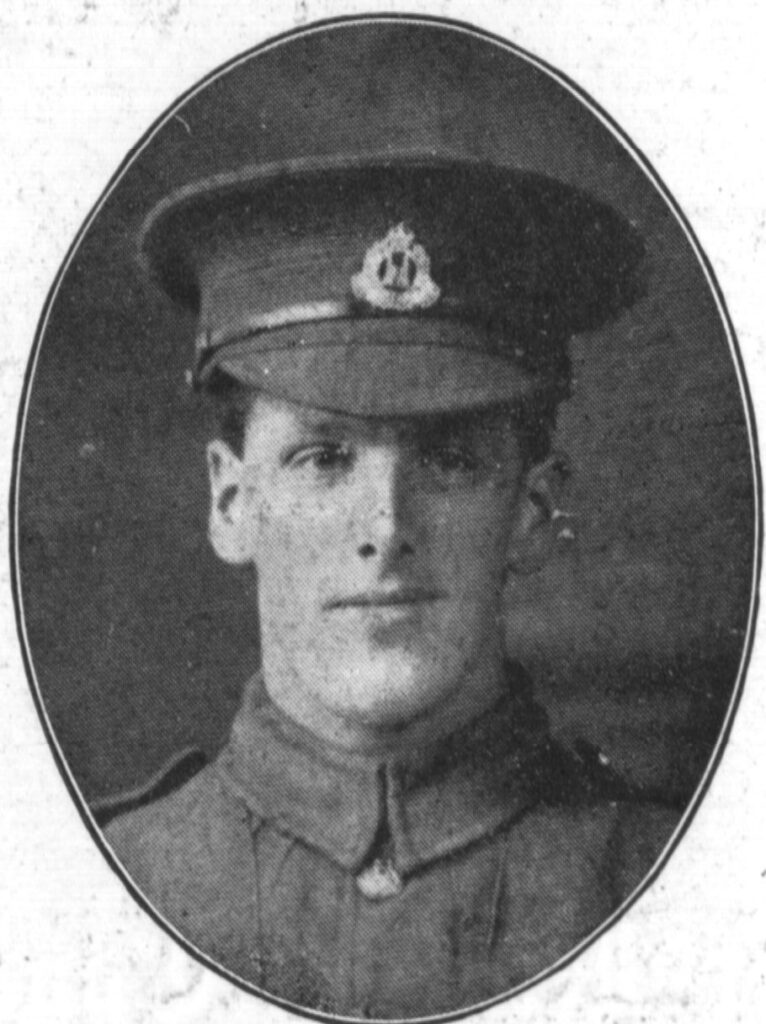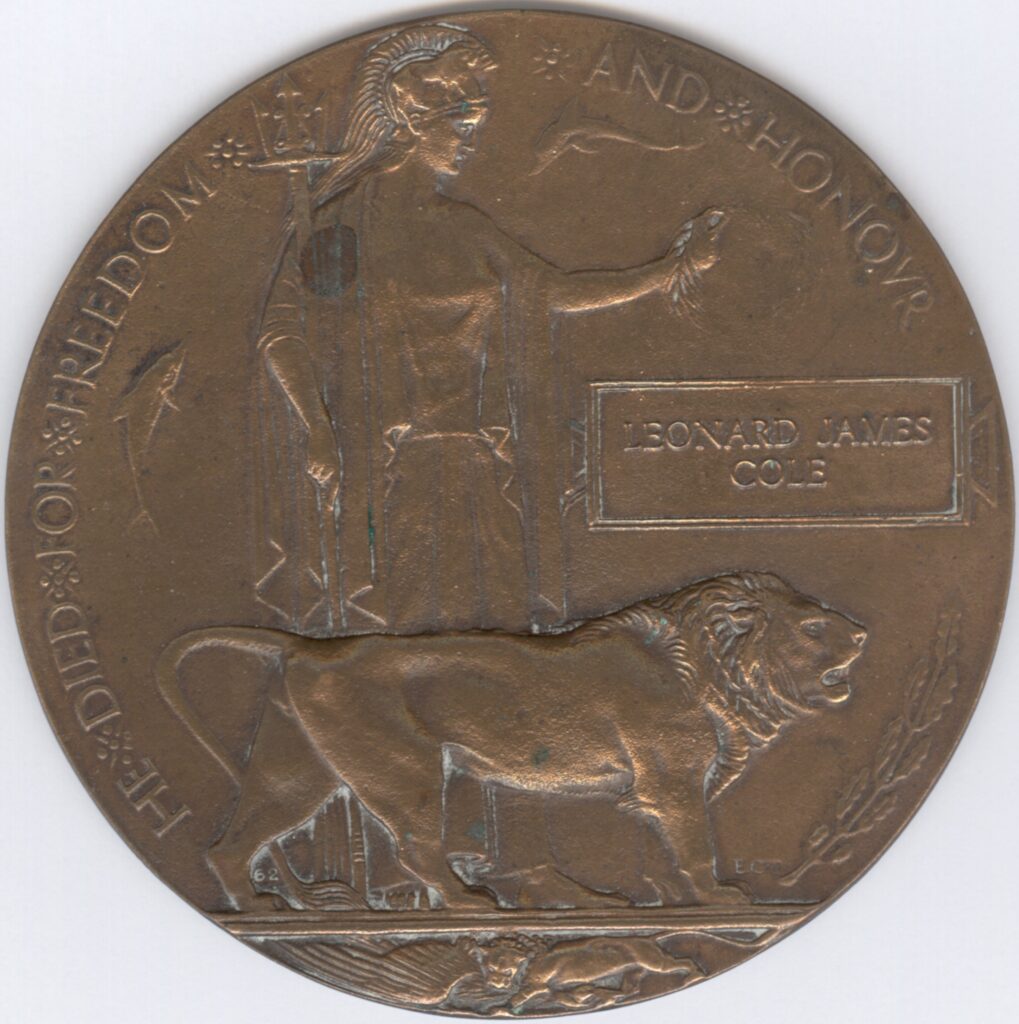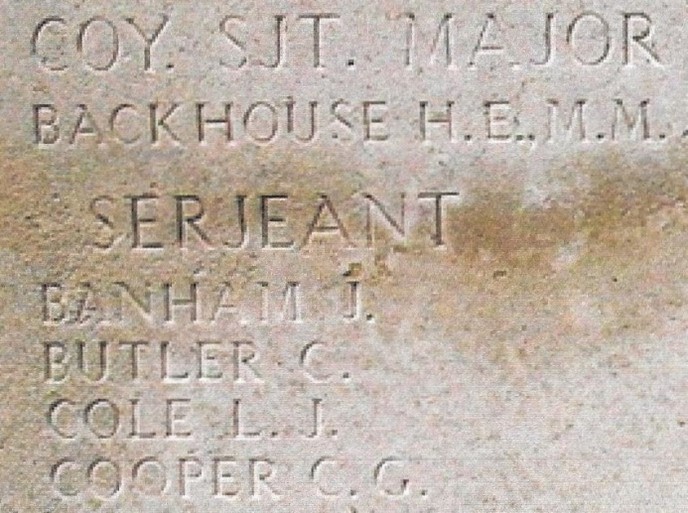200374 SERGEANT (ACT C.S.M.)
LEONARD JAMES COLE
1/4TH BATTALION SUFFOLK REGIMENT T.F.
KILLED IN ACTION
26TH SEPTEMBER 1917
AGE 23 YEARS
Leonard James Cole had been born in Halesworth during the third quarter of 1894. He was the fourth child of seven raised by John, a coal merchant, and his wife Catherine (née Leach) at their home in London Road. On beginning his education, a young Leonard soon proved himself to be a more than average sportsman, particularly on the soccer field where he later went on to play for local senior teams, although his main claim to fame in the sporting arena came in 1907 when he was one of the Halesworth Boys School relay swimming team who won the Lady Gooch Challenge Shield. This competition was held annually and was hotly contested by all of the local schools, including six from the seaside town of Lowestoft. The Halesworth Times newspaper of 1st October 1907, in reporting their victory, compared the facilities of the Lowestoft teams, who had free access to the town’s swimming baths with the local lads who carried out all their training in the river Blyth. The small named silver shield that at the time had been attached to the trophy illustrates just how the forthcoming War to End All Wars would decimate an entire generation of British manhood with three of the four boys named, including Leonard, going on to lose their lives, the fourth being discharged from the army due to wounds.
It is also believed that not only did Leonard excel at sport. On leaving school he was accepted to begin a much sought-after apprenticeship with Smith and Co., the East Suffolk Carriage and Motor Works at their premises in Bridge Street, Halesworth. He had followed his elder brother John who, having completed his apprenticeship with Smiths was, by the time of the 1911 census, being employed by a coach-building company in Harrogate, Yorkshire. At the outbreak of hostilities in August 1914, Leonard, after the initial rush to sign up had died down, had eventually volunteered to serve in the Suffolk Regiment in mid-November with the Regimental number of 2750. He was originally posted to serve in the 11th (Service) Battalion, Suffolk Regiment. By this time, the Army had such a backlog of volunteers requiring to be trained to become a soldier, it would be a full year before he was sent to the front. His time came when he landed at Rouen, France, on 23rd January 1916. Soon after, on 4th February, he was posted to join ‘C’ Company, 1/4th Suffolk’s where he would have met up with several old Territorial friends from the town. During the following months, Leonard, with his Battalion, would have spent several periods both in and out of the firing line, including, after 14th July, becoming involved in the Somme battles whereby the end of that month, they had suffered a total of three hundred and fifty-four casualties in dead and wounded. To make up for some of these losses in junior leaders, Leonard was promoted to Lance Corporal on 29th July. Within a month of receiving his first stripe he had suffered a slight wound but had returned to duty within five days where he must have continued to impress his superiors, as within six weeks he received further promotion to that of a full Corporal while serving in the trenches.
For the remaining months of 1916, the 4th Suffolks continued to be involved and included in several actions both major and minor, each causing a loss in both Officers and Men, with many of the original Territorials now missing from their ranks. The new year of 1917 found Leonard and his comrades now located in the area of the northern French hamlet of Villiers-Sous-Ailly where they underwent three weeks of further training. Shortly after, and under a new Army directive, all units of the Territorial Force would be brought into line with the Army’s regimental numbering system in which all of their soldiers would now have a six-digit number from a block allocated to the Suffolk Territorials. Leonard, who had also received further promotion, became 200674, a Lance Sergeant. In mid-April 1917, his battalion received orders to relieve the 1st Cameronians from their trenches. This included a section of the old German Hindenburg Line. The relief took place during the night of the 16th and 17th. As with similar situations, the Germans were not slow to react to troop movements. During their barrage of artillery and machine gun fire that followed, the 4th Suffolks suffered four soldiers killed and thirteen wounded, Leonard being one of the latter, having received a gunshot wound to his back. After receiving treatment at No.2 Casualty Clearing Station on 20th April, he was admitted to the 18th General Hospital. Here he remained for the following seven weeks until he was considered fit to re-join his Battalion. Shortly after his return to active service, he had been granted a full month’s home leave. Whether he returned to Halesworth is not known as by this time his parents had relocated to the Hyson’s Green area of Nottingham where his father John was now engaged in work for the Government.
In an item written in the Halesworth Times in March 1917 his parents thanked the people of the town and surrounding area for their support during the time they had been in business. They also reported that all of their five sons were serving in the army in France, with their third son William having been reported as missing during the previous July.
On 30th July 1917 Leonard returned to the 4th Suffolks who were at that time in the process of leaving the Somme region for new battlefields in the Flanders area of Belgium. Within weeks of their move, he had received further promotion in rank, now acting in the role of the Company Sergeant Major in ‘C’ Company, this being the most senior Non-Commissioned rank within a company. This once again illustrates how highly he was regarded by the senior Officers within the Battalion, especially considering his young age of just twenty-three years. By mid-September 1917, the 4th Suffolks were holding a section of the support line in the area of Bellegoed Farm. On the 24th of the month they were ordered forward in preparation for a planned attack on the German trenches that was due to be mounted at 5.30am on the morning of the 26th. It was while the Battalion were preparing themselves ‘To Go Over The Top’ that the German artillery, sensing something was afoot immediately laid down a barrage, once again concentrating their fire on the British front–line trenches. This caused casualties among the tightly packed troops who were formed up for the attack. Just fifteen minutes after the scheduled time, the remnants of the battalion broke out of the confines of the trench and headed in the direction of the German line, one small party of just twenty or so men led by Captain Stuart Scrimgeour M.C. who had local connections to Halesworth and would later live at Wissett Hall. He with another Officer and some men, managed to enter a section of the German front line which they held for some time before hearing the order to withdraw. This they then carried out, taking with them two captured heavy machine guns and thirteen prisoners. It is not known if Leonard would have been a member of this group or had become a casualty earlier during the German barrage, but following a roll call it was found that the Battalion had lost a total of two Officers and forty-three men killed, with a further sixty-three men missing. Leonard was one of the latter as his remains were neither found nor identified. Today Leonard is remembered on the Tyne Cot Memorial to the missing.
The Halesworth Times newspaper of 30th October 1917 reported on Leonard’s loss. Although his mother and father had recently moved home, they and their sons were still much respected in the town.
As neither his father nor his mother was dependent on their son’s earnings, they did not qualify for a military pension, although his father, having been nominated as his son’s next of kin, had received a war gratuity of £22.2s.6d (£22.12p).
He was also entitled to claim his son’s medal awards of the British War and Victory medal pair, the location of these is unknown. While his named memorial plaque and scroll remain in the care of his family, for whom we would like to thank for the images of the Cole Brothers. (See below).
Leonard’s name listed on the Tyne Cot Memorial to the Missing
.



